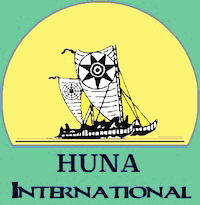Huna Article
Huna International
Hawaiian Facts
by Serge Kahili King
As I have discovered in my travels, it is a mistake to assume that people know very much about our fiftieth
State, so here are some facts to give you a better sense of the spiritual home of our teaching.
The State of Hawaii is a fifteen hundred mile long chain of 132 islands, reefs and shoals stretching from
the
southeast at about the latitude of Mexico City to the northwest at about the latitude of Houston. However,
99.9 % of the land area is on a fairly close group of eight major islands around the lower latitude. In land
area only, the State is larger than Connecticut. The 1980 census showed a population of almost one million
persons living in the State, with 80% of them living on Oahu.
Hawaii, "the Big Island," (or Hawai'i) from which the State gets its name, has about two-thirds of the land
area. No one knows what the name means because it is probably part of a much older name, but one possibility
is "Place of the Water of Life." The island is famous for its orchids, coffee, macadamia nuts, and
volcanoes.
In fact it has five large volcanoes. Mauna Kea (where it snows sometimes) and Kohala (in the north) have not
erupted in historical times. Hualalai, overlooking Kona on the west coast, last erupted around 1800. Both
Mauna Loa (tallest mountain in the world measuring from sea bottom) and Kilauea (legendary home of Pele)
still
erupt frequently. A new volcano, Loihi, is erupting underwater about twenty miles off the southern coast.
Maui, the second largest island, is shaped like Tahiti with two volcanoes and a valley between. Many believe
it is named after the shaman hero of legend, Maui Kupua. Its largest volcano, Haleakala, last erupted in
1790.
Maui is famous for pineapples, Lahaina (an old whaling port and modern tourist mecca), superb sweet onions,
and condominiums. Maui also produces some very good pineapple and grape wines. On the northeast coast are
the
lush jungles of Hana and the Seven "Sacred" Pools (which were used for bathing and laundry and have nothing
sacred about them at all except for the fact that they are part of Maui).
Oahu (or O'ahu), third largest, is usually called "The Gathering Place" which may come from its name meaning
"collection" or "heap" or may just refer to it as a population center. Oahu is famous for Diamond Head,
Honolulu, Waikiki, and Pearl Harbor, as well as many military bases. It is "in" to put down Waikiki as a
tourist trap, but it still has the best shopping and one of the finest beaches in the islands. The Bishop
Museum in Honolulu is a wonderful place to study old Hawaiian culture. Oahu is also famous for some of the
best surfing in the world on its North Shore, and sometimes the most dangerous (30 foot winter waves).
Kauai (or Kaua'i) is the fourth largest island. Called "The Garden Isle", its name can mean "The Great
Rains." Today it is considered by Hawaiians as the most spiritual place in the islands. It is famous for its
magnificent natural beauty, including the Fern Grotto and the Na Pali Coast, for the legendary Menehunes
(Hawaiian elves in the very old sense), the high mountain forests of Koke'e, the dangerous and mysterious
Alaka'i Swamp, Mt. Waialeale (wettest spot in the world with 451 inches annually) and as the home of Aloha
International.
Molokai (or Moloka'i), the fifth largest, is now called "The Friendly Island," but a few years ago it was
called "The Lonely Island." A desire for tourism prompted the change. I think the name means "to train
(ka'i)
to tie bundles (molo)" and refers to the training of kahunas, for it is a fact that there were more schools
there than anywhere else. Molokai is famous for its former leper colony, its mule rides down cliff trails,
its
many temples, and its low level of development.
Lanai (or Lana'i) is the sixth largest and called the Pineapple Island because that's mostly what used to
grow there. The name means either "stiff-backed," referring to its single ridge, or "porch" (referring to it
as the porch of Maui, perhaps). The pineapples are gone now and resort development has taken their place,
but
there is still a lot of empty land and isolated beaches. The island's population is around 2000.
Niihau (or Ni'ihau), the seventh largest, is called "The Forbidden Island" and a lot of tourist hype is
played around that. Actually, it is forbidden because the whole island of 70 square miles is a private
ranch,
owned by the Robinson family. Tourist agencies like to give the impression that the Hawaiians there live in
the old ways, but what that really means is that they live in a company town like the plantation era of the
1800s. The island is famous for a particular kind of shell necklace made there and the population of the
single village is about 200. Hawaiian is the first language through 3rd grade, according to the last I
heard.
The smallest "major" island is Kahoolawe (or Kaho'olawe), only 45 square miles. The name means "The One That
Was Taken Away." I don't know when that name was given, but that's how the Hawaiians and the State of Hawaii
feel about it today because after Pearl Harbor the Navy took it over for bombing practice and still won't
give
it back. There is currently a strong movement to make it into a center for Hawaiian culture, and some
progress
has been made in that direction. The old name of the island was Kanaloa, also an ancient god of the sea, and
it was an important place for navigation training.
Copyright Huna International 2002

|

